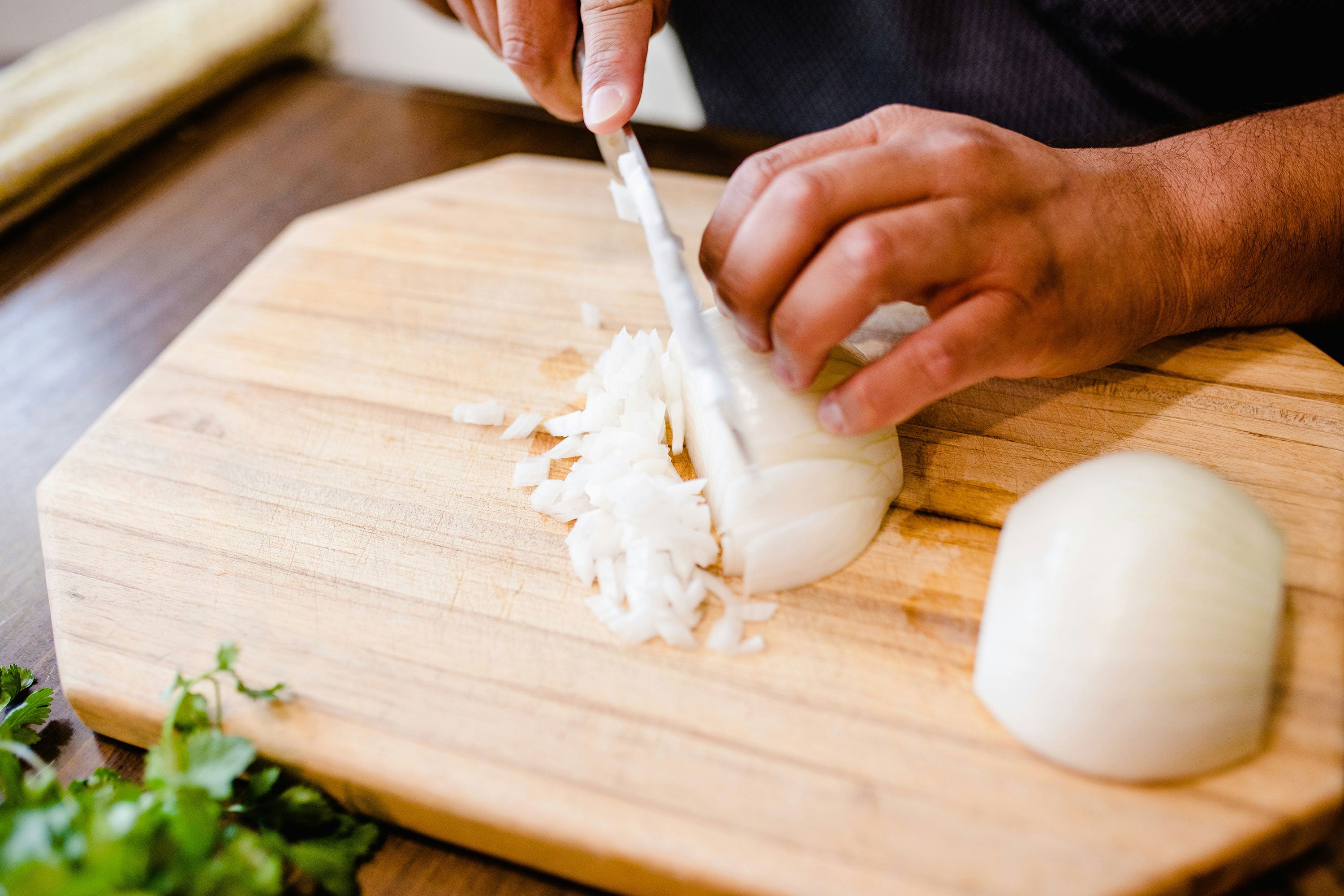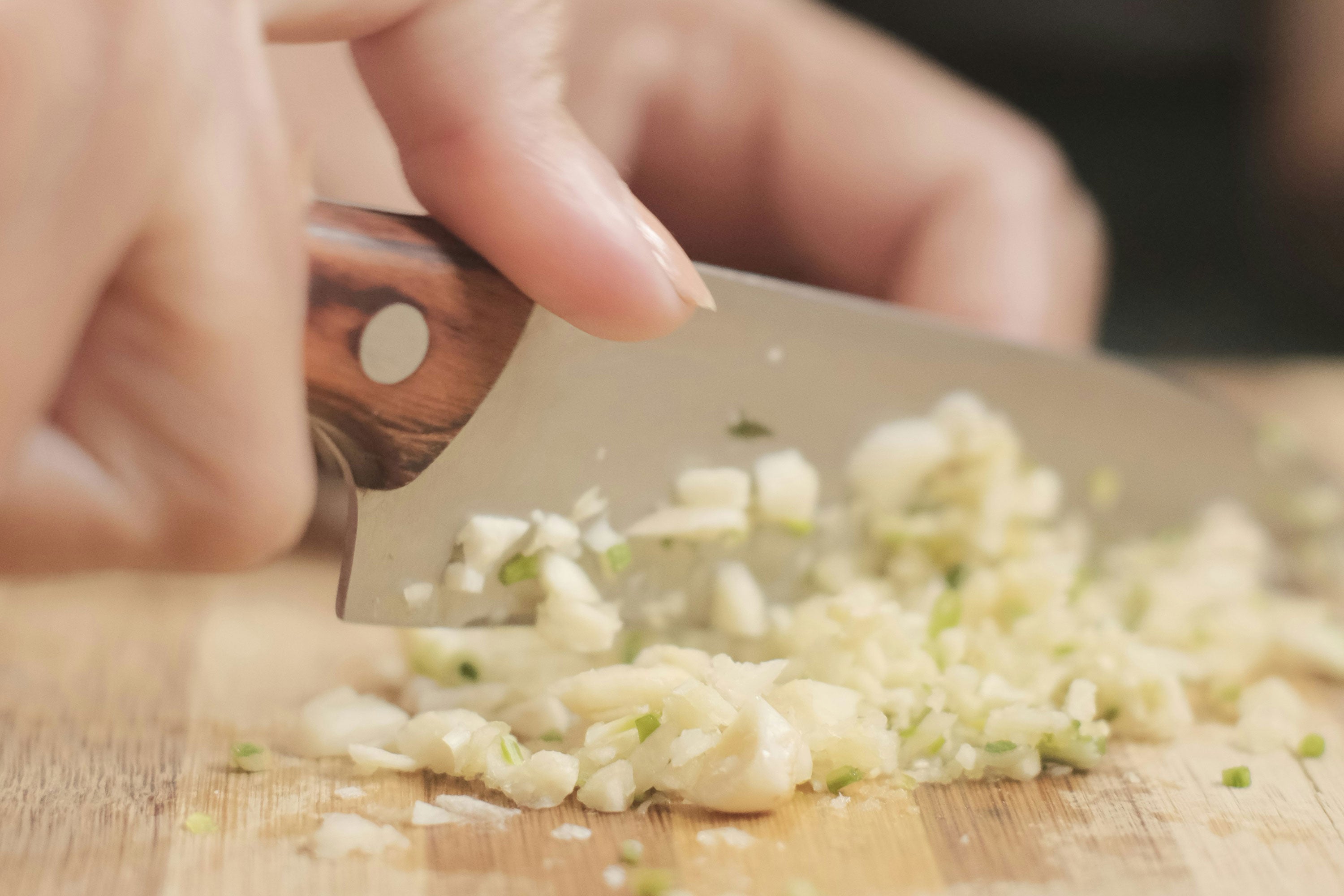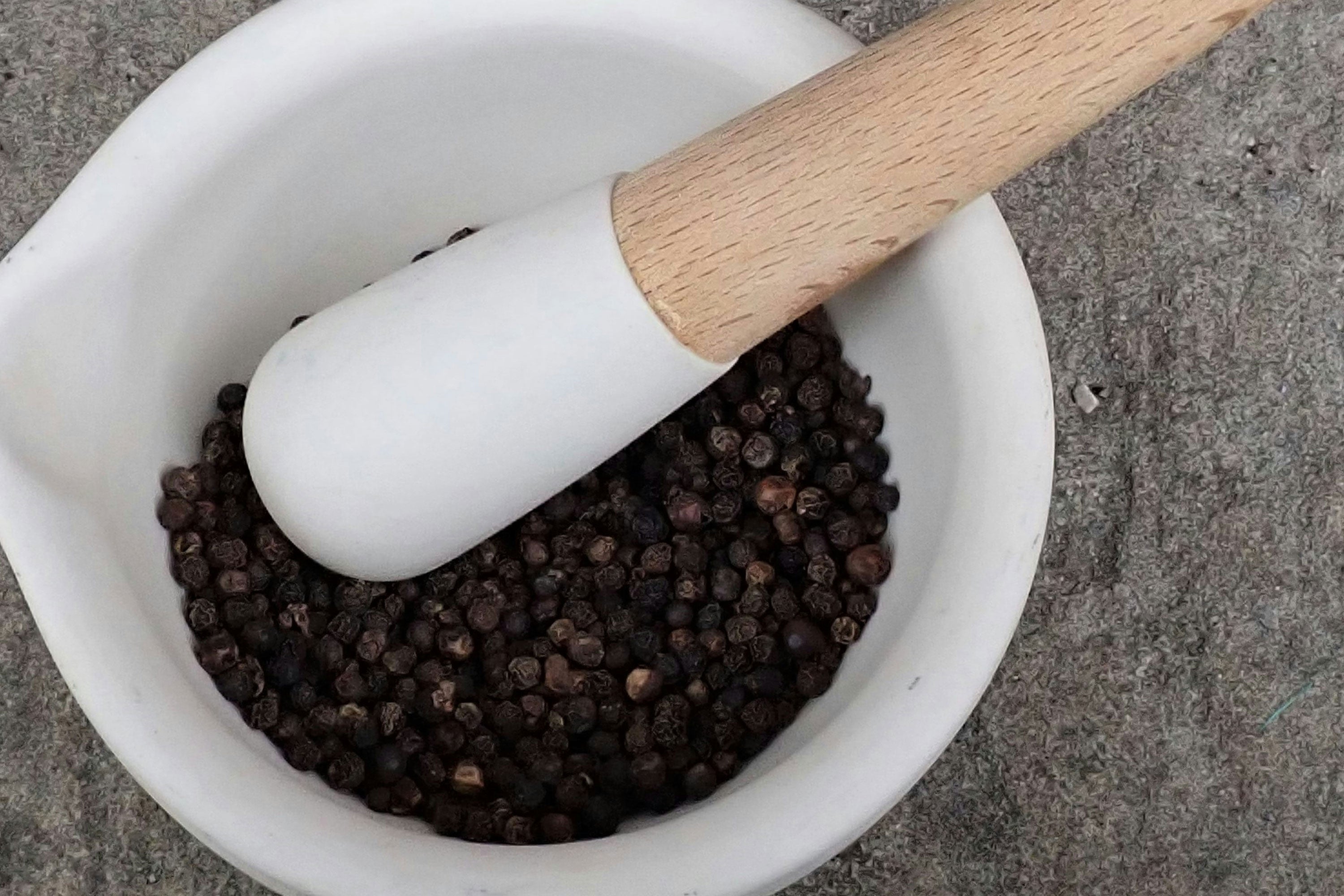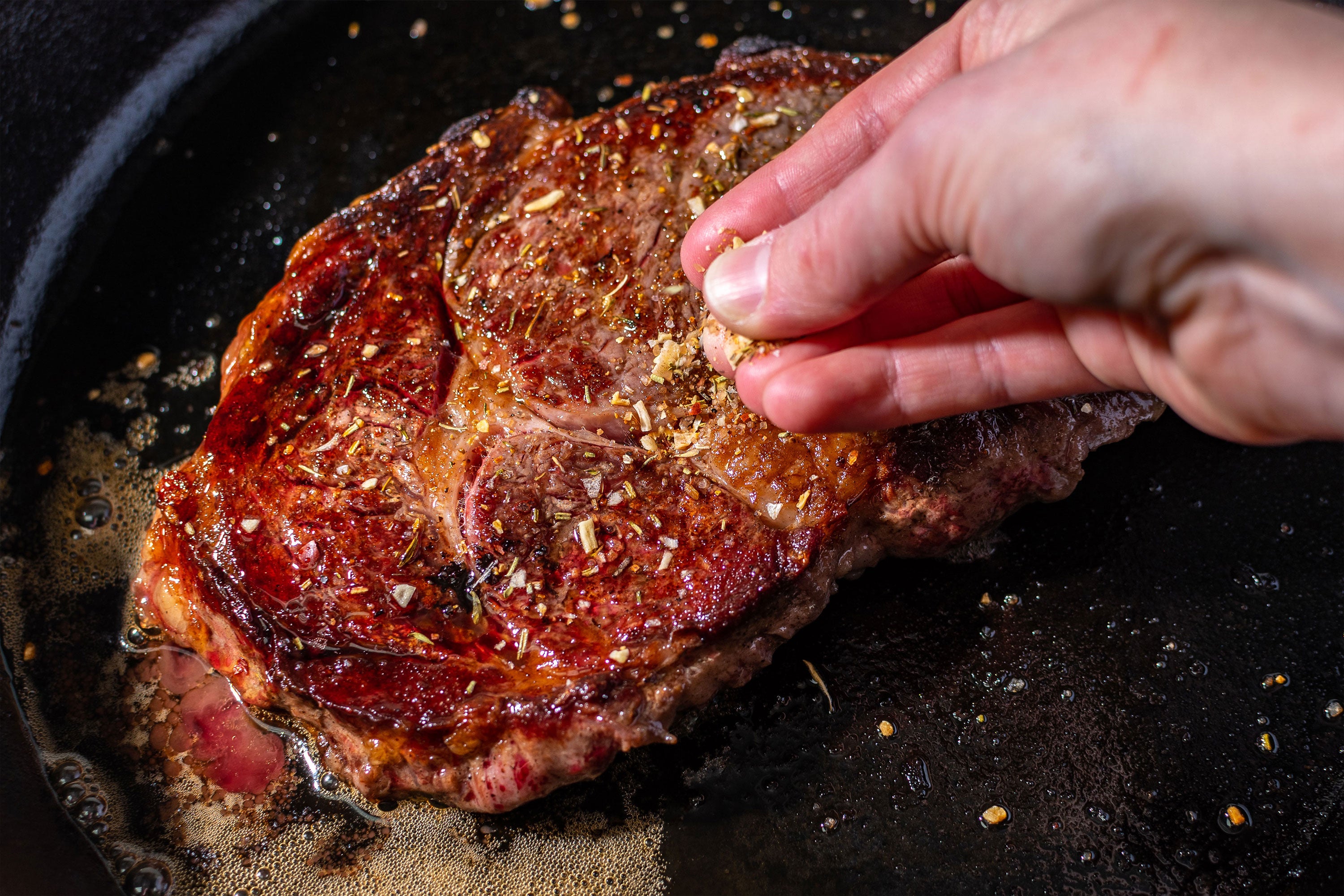How to Cut an Onion
Cutting onions doesn’t have to result in absolute allium carnage on your cutting board. Like you'll see in the photo below, most people start by cutting off both ends: the top and the root. Stop doing that!
The real secret here is to keep the root attached. Without it, everything falls apart. Trust us, this will change your life. Cut the top of the onion, as you probably already do, and then cut it in half from tip to root. You won't end up with the entire root attached to one of the halves but even keeping part of the root on will effectively hold the onion together - preventing that pesky slippage and making it so much easier to uniformly chop an onion.

Let’s break this down:
- Cut off the top of the onion.
- Place the onion cut-side down with the root up and cut in half.
- Peel papery layers from both halves.
- Place one half flat-side down with the root pointing away from you. Use only the tip-end of your knife and, starting on either side, make slices that follow the angle of the onion so that each slice stays attached at the root.
- Rotate the onion 90 degrees and make perpendicular slices towards the root. You’ll be left with a neat pile of diced onion and a little root stump to compost.
Bonus Tip: This technique also works for slicing onions. Just stop at Step 4.
How to Mince Garlic
What exactly is a mince? It's actually pretty simple. Think of it as a cut that is slightly finer than a chop. You've probably seen the jars of pre-chopped garlic in the grocery store. While they are fine in a pinch, garlic (like just about everything else) starts to lose its flavor once it is cut. If you're not into chopping, consider our dehydrated Minced Garlic (which can be rehydrated in warm water or added directly into stews, soups, and more).
But back to the topic at hand. Think of a mince as a fine chop. Many recipes will call for minced garlic. This is basically a consistency that's finer than a chop and larger than paste or puree. Perfect this essential cut in just a few steps.

- Remove a clove from a head of garlic.
- Carefully use the side of your knife to press down on the clove just enough to crack open the papery shell.
- Peel.
- Make a few rough slices to start.
- Plant the tip of your knife above the pile of garlic. Place the hand that isn’t holding the knife flat on top of the front of the blade.
- The front of the knife stays in place and the back pivots back and forth as you chop. When the pieces of garlic spread out, use your knife to bring them back together and repeat until you have a pile of tiny pieces of garlic (like 1/8-inch or smaller).
How to Use a Mortar and Pestle
We're leveling up slightly here. When it comes to spices, it's perfectly fine to buy your spices pre-ground, as long as you keep them fresh (store them out of direct light and away from heat sources like your stove). Hint: If your spices don't have much smell, they probably don't have much flavor either.
But one of the best ways to keep your spices fresh is to buy whole spices and grind them yourself. And, like Alton Brown, we are fans of "multi-taskers" (tools that can be used for more than one purpose). A coffee grinder actually can double as a spice grinder but you might want to avoid weird flavors in your coffee by having a dedicated spice grinder. Or go old-school and try a mortar and pestle instead.

- Add just enough whole spices—such as Four Corners Peppercorns—to cover the bottom of the mortar (the bowl) and use the pestle (the stick) to grind them down to your desired size.
- Let the weight of the pestle do most of the work: crushing in a circular motion and adding additional pressure as needed.
- Grinding your spices this way releases essential oils that will add depth of flavor to your dishes. Plus you get to feel like a witch preparing a potion, so there’s that.
How to Sear a Steak
Impress everyone, including yourself, by searing up the steak of every carnivore’s dreams with a few simple tips, a meat thermometer, and a little bit of practice. But, as with many things when it comes to cooking, making the perfect steak actually starts before you even think about heating up a pan.
Leaner cuts, like flank or round steak, are ideal for flavorful marinades. But when it comes to a juicy steakhouse style, you'll want to look for a fattier cut. like ribeye. Keep an eye out for a well-marbled cut, where the fat is running throughout the meat. Fat = flavor.

- Let your steak of choice sit out, uncovered, for 30 min. to an hour. You will achieve a better sear if the surface of the meat is dry and about room temperature. Otherwise, the initial blast of heat from your hot pan will be wasted evaporating surface liquids.
- You also want to generously season your steak early on, giving the salt enough time to draw out some moisture from the meat, which then dissolves some of the salt and pulls it back into the meat.
- Note: Now is probably a good time to tell you to open a window and turn on any vents or fans you have as well. It’s about to get a little smoky up in here.
- Heat up a heavy-bottomed pan over high heat with just a splash of oil with a high smoke point (like avocado or grapeseed, not olive). The pan should be aggressively hot.
- Using tongs, carefully lay the steak in the pan away from yourself. If your pan is hot enough, it should start to pop and sizzle immediately. Flip only once steak releases easily from the pan and a dark golden-brown crust has formed.
- There are several variables that affect the timing of this process (the thickness of your steak, the various temperatures involved, and what color apron you’re wearing) so it’s best to rely on other indicators besides time to tell when the steak is done. The big one is internal temperature, so bust out that thermometer and follow this helpful chart.

- Rest the steak for 5 to 10 min. (so it can finish cooking and retain more of the juices) and slice against the grain (shortens the muscle fibers for more tender bites) before serving.
Note: This same type of technique can be used to make the perfect burger, pork chops, and more.
Whether you call them helpful hints, tricks of the trade, or kitchen hacks, we are sure these will help take your cooking to the next level!
What do you want to learn to cook? Share with us in the comments below and tag @savoryspiceshop on Instagram as you show off your cooking skills!.
